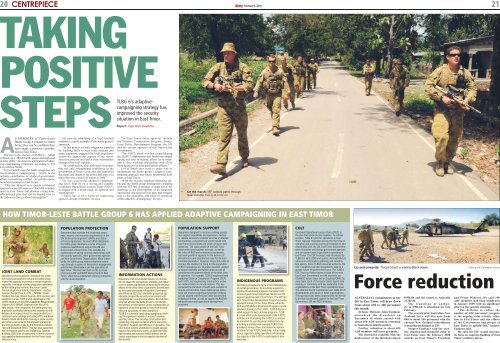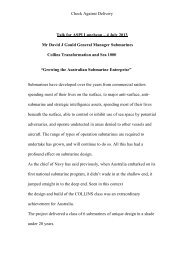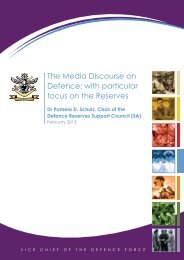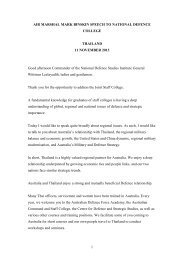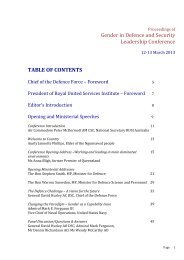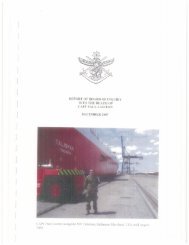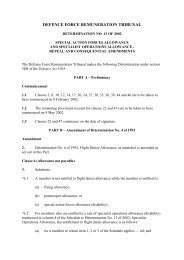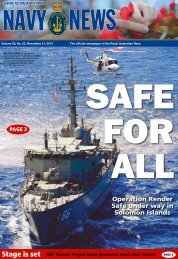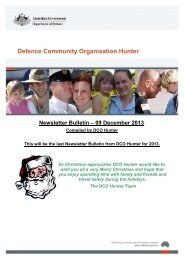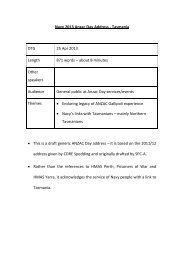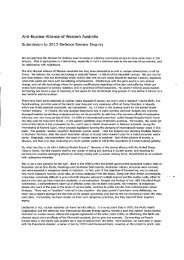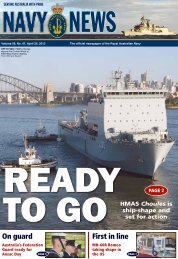right royal visit p2 7 bde's grand send - Department of Defence
right royal visit p2 7 bde's grand send - Department of Defence
right royal visit p2 7 bde's grand send - Department of Defence
You also want an ePaper? Increase the reach of your titles
YUMPU automatically turns print PDFs into web optimized ePapers that Google loves.
20 CENTREPIECE Army February 4, 2010 21<br />
TAKING<br />
POSITIVE<br />
STEPS<br />
AS MEMBERS <strong>of</strong> Timor-Leste<br />
Battle Group 6 prepare to return<br />
home, they can be confident they<br />
have made a positive contribution<br />
to East Timor.<br />
The key to the success <strong>of</strong> TLBG 6 – which<br />
is based on a 2RAR battle group and deployed<br />
in June 2009 – has been its application <strong>of</strong> adaptive<br />
campaigning principles, according to CO<br />
Lt-Col Dave Smith.<br />
Lt-Col Smith says the battle group has tailored<br />
adaptive campaigning – which is the<br />
military contribution to whole-<strong>of</strong>-government<br />
efforts to resolving conflict – to suit the operational<br />
environment in East Timor.<br />
“This has allowed us to ensure a balanced<br />
approach across all aspects <strong>of</strong> the ADF commitment<br />
to East Timor and develop a long-term,<br />
effects-based plan that can be handed over to<br />
the follow-on force without interruption.”<br />
He says the rebuilding <strong>of</strong> a local football<br />
stadium is a good example <strong>of</strong> the battle group’s<br />
approach.<br />
“In this project we built indigenous capacity<br />
by teaching skills to local trade students and<br />
army engineers, engaged the local population<br />
to provide support for aspects <strong>of</strong> the reconstruction<br />
process and had a firm information<br />
strategy to tie it all together.<br />
“In combination, this delivered outcomes<br />
that not only strengthened confidence in the<br />
government <strong>of</strong> Timor- Leste, but also reinforced<br />
the status and image <strong>of</strong> the police and army in a<br />
place that was a source <strong>of</strong> unrest in 2006.”<br />
He says successful adaptive campaigning<br />
relies heavily on a strong and capable<br />
Combined Operational Liaison Team (COLT)<br />
to engage with a broad range <strong>of</strong> agencies and<br />
organisations.<br />
“There has to be a focus on supporting<br />
agencies already in theatre,” he says.<br />
TLBG 6’s adaptivecampaigning<br />
strategy has<br />
improved the security<br />
situation in East Timor.<br />
Report: Capt Chris Hawkins<br />
“In East Timor these agencies include<br />
the <strong>Defence</strong> Cooperation Program, Timor-<br />
Leste Police Development Program, the UN<br />
and the various agencies <strong>of</strong> the Timor-Leste<br />
Government.<br />
“The COLT, which was first created during<br />
the TLBG 5 deployment and further developed<br />
during our time in theatre, allows us to maintain<br />
a close working relationship with all <strong>of</strong><br />
these agencies via dedicated liaison <strong>of</strong>ficers.”<br />
Lt-Col Smith says work is under way to<br />
incorporate the battle group’s adaptive campaigning<br />
approach into future operational level<br />
plans in East Timor.<br />
“With the security situation remaining stable<br />
and the battle group headquarters merging<br />
with the JTF HQ to produce a single force, the<br />
challenge is the development <strong>of</strong> an integrated<br />
operational and tactical level plan that remains<br />
true to the principles and lines <strong>of</strong> operation<br />
within adaptive campaigning,” he says.<br />
HOW TIMOR-LESTE BATTLE GROUP 6 HAS APPLIED ADAPTIVE CAMPAIGNING IN EAST TIMOR<br />
JOINT LAND COMBAT<br />
Operations have focused on individual and collective<br />
training programs to ensure the battle group<br />
retains the capacity to provide a robust-response<br />
capability. Individual training programs undertaken<br />
by the battle group include: the Junior Leader<br />
Course; Supervisor Infantry Operations – section<br />
courses; Subject Two for CPL – RAEME; Visual<br />
Trackers Courses; drivers courses; CFA courses; and<br />
weapons courses.TLBG 6 also capitalised on the<br />
recent adoption <strong>of</strong> the Army Capability Requirement<br />
Infantry 2012 ORBAT. Deployed with two 2012<br />
light infantry rifle companies, the battle group has<br />
practised coordinated dismounted manoeuvre with<br />
delivery <strong>of</strong> increased direct fire weapon effects in<br />
combined-arms settings (including APCs and Black<br />
Hawks). Blank and live-fire training in close country<br />
and urban environments has allowed operational<br />
test and evaluation trials by the Australian <strong>Defence</strong><br />
Test and Evaluation Office. This has also supported<br />
the information actions and Indigenous Capacity<br />
Building (ICB) lines <strong>of</strong> operations in terms <strong>of</strong> providing<br />
capability demonstrations for the Timor-Leste<br />
<strong>Defence</strong> Force.<br />
POPULATION PROTECTION<br />
Operations that maintain the situational awareness,<br />
security and response requirements <strong>of</strong> the<br />
UN Technical Arrangement (UNTA) and Status<br />
<strong>of</strong> Forces Agreement. To meet UNTA obligations<br />
the battle group maintains a series <strong>of</strong> layered<br />
response capabilities to support the UN and<br />
Government <strong>of</strong> East Timor. This includes the<br />
maintenance <strong>of</strong> strong working relationships with<br />
UN security agencies, other government agencies<br />
and Non-Government Organisations. More importantly,<br />
the battle group retains situational awareness<br />
through a system <strong>of</strong> hierarchical engagement<br />
with the key stakeholders and the population <strong>of</strong><br />
East Timor. This has been built on the success<br />
<strong>of</strong> previous ADF and NZDF deployments to East<br />
Timor, which have established a strong connection<br />
with the local population.<br />
INFORMATION ACTIONS<br />
Operations with coordinated delivery <strong>of</strong> information<br />
to shape the perceptions, attitudes and behaviours<br />
<strong>of</strong> target populations, enhancing the physical<br />
effects <strong>of</strong> the other lines <strong>of</strong> operation. Coordinated<br />
by the newly-developed Information Dominance<br />
and Influence (IDI) Cell, the battle group has significantly<br />
shaped the security environment with<br />
complimentary non-physical effects. IDI Cell planning<br />
has allowed the battle group to coordinate<br />
the delivery <strong>of</strong> information across multiple lines <strong>of</strong><br />
operation at decisive points to maximise the benefits<br />
and successes <strong>of</strong> these operations.<br />
TLGB 6 is currently conducting operations involving<br />
the significant rebuild <strong>of</strong> an East Timorese<br />
sporting venue. This includes construction and<br />
mentoring programs to deliver effects along the<br />
Population Support and ICB lines <strong>of</strong> operation. The<br />
information actions undertaken to shape popular<br />
support for preliminary works, an opening event,<br />
sponsorship and national media interest, are <strong>of</strong><br />
critical importance to the successful outcome <strong>of</strong><br />
this activity.<br />
On the march: ISF solders patrol through<br />
Suai districts. Photo by AB Jo Dilorenzo<br />
POPULATION SUPPORT<br />
Operations designed to reinforce existing population<br />
support capabilities and agencies to restore<br />
or replace necessary essential services <strong>of</strong> affected<br />
communities, consistent and synchronised with<br />
East Timor Government and whole-<strong>of</strong>-goverment<br />
objectives. The rapid growth <strong>of</strong> the East Timor<br />
Government and business services, as well as<br />
the influx <strong>of</strong> NGO and commercial businesses,<br />
has seen growth in capacity for the delivery <strong>of</strong><br />
infrastructure and essential services for the East<br />
Timorese population. However, scope still exists to<br />
improve the standard <strong>of</strong> living for the population.<br />
TLBG 6 operations are, wherever possible, aligned<br />
to support AUSAID and NZAID goals as well as<br />
complement the planned effects <strong>of</strong> the other lines<br />
<strong>of</strong> operation. For example, TLBG 6 engineers have<br />
supported <strong>Defence</strong> Cooperation Program (DCP)<br />
and F-FDTL-led engineering construction works<br />
for medical clinics in remote regions. This has<br />
increased the standard <strong>of</strong> health care available to<br />
remote communities. Future battle group operations<br />
will involve a significant engineer bridging<br />
activity aligned with the East Timor Government<br />
bridging priorities, as well as support to AUSAIDled<br />
governance and agriculture development<br />
programs.<br />
INDIGENOUS PROGRAMS<br />
Operations designed to nurture the establishment<br />
<strong>of</strong> civilian governance, by providing support to<br />
existing development programs consistent with<br />
whole-<strong>of</strong>-government objectives. Numerous ICB<br />
support agencies exist in East Timor. The AFP-led<br />
East Timor Police Development Program provides<br />
specialist training to the Timor Police, while the<br />
DCP and NZ Military Assistance Program provide<br />
specialist training to the F-FDTL. TLBG 6 has provided<br />
support to each <strong>of</strong> these programs. TLGB<br />
6’s main effort is the development <strong>of</strong> the F-FDTL<br />
with the aim <strong>of</strong> assisting the F-FDTL to continue<br />
its transition to a pr<strong>of</strong>essional military force by<br />
providing a pr<strong>of</strong>essional example. TLBG 6 has<br />
provided a series <strong>of</strong> live- and blank-fire demonstrations<br />
for key F-FDTL leadership. Future indigenous<br />
capacity building operations will develop<br />
the capacity <strong>of</strong> the F-FDTL to participate in joint<br />
exercises.<br />
COLT<br />
Combined Operational Liaison Team (COLT) is<br />
the glue that binds the plan together. To achieve<br />
success, TLBG 6’s plan for operations in East<br />
Timor requires integration across the five lines <strong>of</strong><br />
operation and a sound working knowledge <strong>of</strong>, and<br />
relationship with, the UN, East Timor Government,<br />
other Australian and foreign government agencies<br />
and non-government organisations operating in<br />
East Timor. The COLT concept was introduced by<br />
TLBG 5 in early 2009 and quickly demonstrated its<br />
value as an information gathering and coordination<br />
agency. Since TLBG 6 assumed authority, the<br />
COLT capability has been expanded to take on a<br />
greater whole-<strong>of</strong>-government focus. The TLBG 6<br />
COLT has four liaison teams in each <strong>of</strong> the main<br />
East Timor Government and UN elements, an<br />
OGA/NGO liaison team and an Engineer/CIMIC fly<br />
away team. Each <strong>of</strong> the liaison teams spend time<br />
meeting or consulting with key leadership in the<br />
organisations at the East Timor operational level.<br />
This informs the ISF Commander and TLBG CO <strong>of</strong><br />
developments and issues in these organisations.<br />
This approach also seeks opportunities for the ISF<br />
to provide coordinated support to the East Timor<br />
Government, UN and NGO initiatives.<br />
Up and onwards: Troops board a waiting Black Hawk. Photo by LAC Christopher Dickson<br />
Force reduction<br />
AUSTRALIA’s commitment to the<br />
ISF in East Timor will draw down<br />
from about 650 to 400 personnel<br />
this month.<br />
<strong>Defence</strong> Minister John Faulkner<br />
announced the drawdown on<br />
December 10 which started with<br />
about 100 ADF members returning<br />
to Australia in mid-December.<br />
Further reduction to about 400<br />
ADF members will occur gradually.<br />
The drawdown coincides with the<br />
deployment <strong>of</strong> the Brisbane-based<br />
8/9RAR and the return to Australia<br />
<strong>of</strong> 2RAR.<br />
The transition <strong>of</strong> authority<br />
to 8/9RAR is scheduled for late<br />
February.<br />
The overall joint Australian-New<br />
Zealand force will decrease from<br />
800 to about 550 personnel with the<br />
current New Zealand contribution<br />
remaining unchanged at 150.<br />
Senator Faulkner said the security<br />
situation had remained stable in<br />
East Timor since the February 2008<br />
attacks on East Timor’s President<br />
and Prime Minister. He said 100<br />
ADF members had been withdrawn<br />
in January 2009 with no significant<br />
effect on the security situation.<br />
“The decision to reduce the<br />
number <strong>of</strong> ADF personnel recognises<br />
the ongoing calm security situation<br />
in East Timor and the efforts<br />
<strong>of</strong> the Government and people <strong>of</strong><br />
East Timor to uphold this,” Senator<br />
Faulkner said.<br />
He said the ISF would increase<br />
its focus on capacity-building <strong>of</strong> East<br />
Timor’s military forces.


